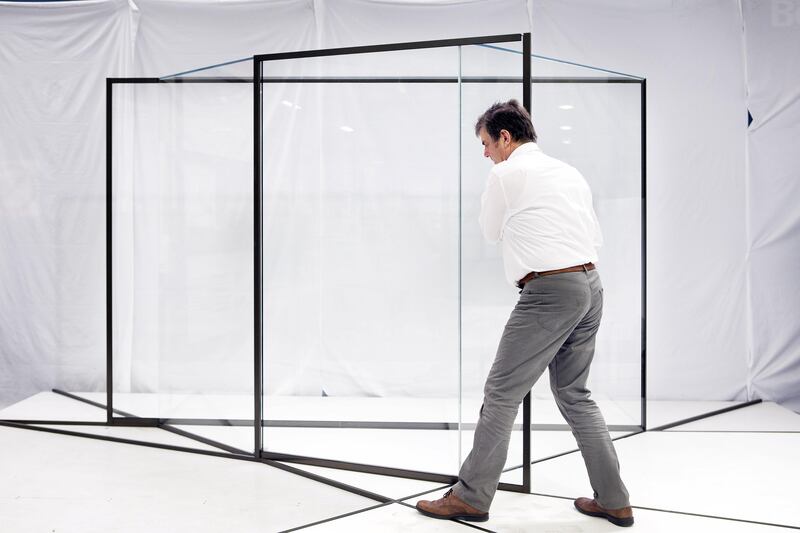Designed to take visitors on a journey that allows them to engage with the cultures of the world, the Louvre Abu Dhabi's galleries will form an interconnected chain with links that represent a series of historic moments that begin in pre-history and end in the present day.
Presenting cultures and objects in dialogue, rather than in nationally or regionally defined displays, the aim is to create a more equitable, global approach to the history of art and humanity.
"We would like to highlight the connections between civilisations, instead of focusing on the differences, as is usually done in international museums, because we believe there is no hierarchy between civilisations," explains Olivia Bourrat, Agence France-Muséums' deputy scientific director.
With its emphasis on important moments of interaction and cultural exchange, the narrative developed by the Louvre Abu Dhabi has to achieve a careful balance between chronological coherence and cultural inclusivity that also has the flexibility to address broader issues and change the way people look at objects, allowing visitors to make comparisons between cultures and epochs.
In displays dedicated to the ancient world, the Louvre Abu Dhabi's collection of Egyptian art contains masterpieces such as the funerary set of Princess Henuttawy, which was acquired by the museum in 2014.
Called "the venerated house mistress" on her mummy case and sarcophagi, Henuttawy was the daughter of a pharaoh from the 22nd dynasty, King Sheshonk, the Lord of the Two Lands, which dates her funeral set to the second half of the 10th century BC.
Made from painted wood, linen, papyrus and plaster, the set includes her body, preserved in a cocoon, which is protected by a richly decorated cartonnage case and three wooden sarcophagi, two of which are well-preserved, while a third contains only fragments.
When displayed alongside other items from the museum's ancient Egyptian collection such a three-metre-long, hieroglyph-covered mummy bandage; a carved and inscribed stone that once formed the apex of a pyramid; and a bronze statuette of the god Osiris, the set provides an insight into Pharaonic-era attitudes to the afterlife, and forms a part of a longer conversation throughout the collection about human representation that extends from the early Bronze Age all the way through to the present.
Displays devoted to the medieval period are another case in point. Although curators have said that there will be a display dedicated to the courtly art of medieval Europe supported by loans from the French national museum of the Middle Ages, the Musée du Cluny, the museum's permanent collection paints a picture of the period that extends from Tang dynasty China through India and Central Asia, the Middle East and Arabia, all the way to the 13th-century West Africa.
It is an approach that not only recognises the influence of important trading networks along the Silk Road and throughout the Indian Ocean, but which also allows a comparative approach to religion in the period by illustrating the various ways in which major traditions such as Islam, Hinduism, Buddhism, Christianity and Judaism each celebrated their own sense of the divine.
Inside the museum, the majority of these objects will be housed in two main types of galleries – called Bronze and Glass – that are defined not by their principal materials and the kind of exhibition environment they are designed to create.
Illuminated by carefully controlled levels of natural daylight, there will be 13 Glass Galleries in the museum and nine Bronze Galleries dedicated to the display of very different objects. The Bronze Galleries will house delicate items, such as works on paper that require lower light levels and greater environmental protection, while the Glass Galleries will be reserved for objects, such as sculpture, that are more environmentally robust.
From Jean Nouvel's Rain of Light to environmental conditions inside the galleries, the control of light is one of the fundamental components of the museum's design.
In the Glass Galleries, the objects will be protected from the potentially damaging effects of Abu Dhabi's harsh sunshine by a sensor-controlled, multi-layered system of blinds that are able to reduce the amount of light in the galleries by anything between 10 and 100 per cent.
As well as controlling light levels, the need to maintain optimum levels of heat and humidity is also essential. The most-delicate objects will be housed in sealed and climate-controlled display cases that are also seismically isolated to be able to resist the potential effects of an earthquake. Conditions in each of the galleries are also controlled by a series of motorised double doors that effectively create an air-lock-type buffer between the interior world of the museum and the outside.
________________
Read more:
Louvre Abu Dhabi: "People said that it cannot be done"
[ Louvre Abu Dhabi: The museum of then, now and the future ]
[ Louvre Abu Dhabi opening date: museum will open its doors on November 11 ]
________________





